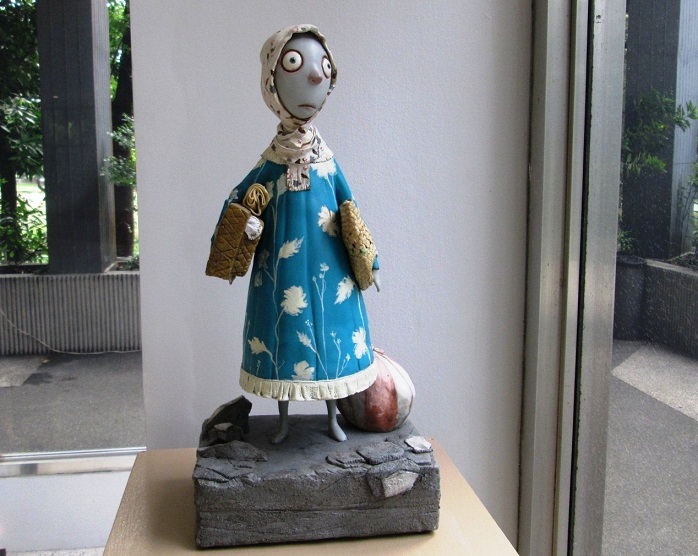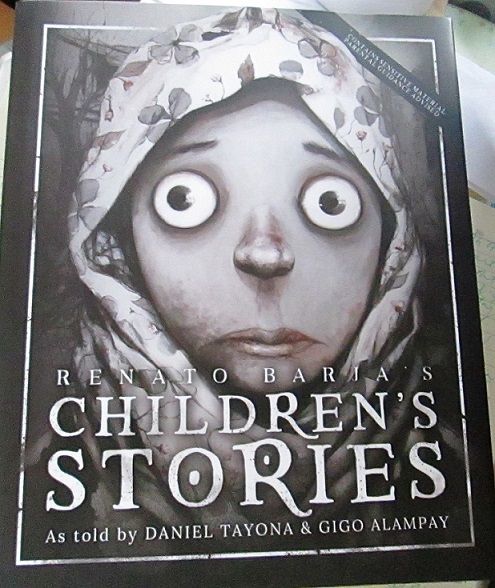
Closeup of The Dumpster Girl
One cannot abandon Renato Barja’s Children’s Stories (as told by Daniel Tayona and Gigo Alampay) without being haunted by the pools of pain found in the exaggeratedly large eyes of his subjects—children who have lost all, especially their innocence. The book comes with a warning: “Contains sensitive material. Parental guidance advised.”
In his preface, Alampay, executive director of the Center for Art, New Ventures and Sustainable Development that published the book, wrote, “The stories in this book do not shy away from sensitive issues. There is poverty, and unsafe homes, drugs and violence. There is hope too, which while born out of an understandable desire for happy endings, it is not naïve. It is one that recognizes the challenges that face children who find themselves in unfortunate situations.”
These are children Barja encountered in Manila and its suburbs. He rendered these “strange, interesting, sad, challenged, and wonderful children,” in Alampay’s description, with a minimalist palette of gray, black, brown and blue.
The English text of the stories comes with a Filipino translation by Rhandee Garlitos. It opens with “The Blind Busker,” who formerly sang in front of a church but was shooed away by the priest who only wanted old folk songs.She now sings in the market where she collects more coins and paper bills.

Construction Boy, left, and Charcoal Girl
There is “Garbage Gloria” who practically lives on the sidewalk, scouring piles of garbage and looking for discarded electronic toys whose copper wire fetches a good price at junk shops. She and her four sisters find the sidewalk safer and avoid staying home at daytime “in case Tatay comes home drunk again.” Already in this short tale there is something sinister implied—the father’s drunkenness can trigger domestic violence or worse, sexual abuse of children.
“I am Superman” tells of the son of Overseas Filipino Workers who is left to be minded by his grandmother and gets “everything I want.” Lola feeds him hotdogs, cake and soda which may explain his bloated stomach and unhealthy pallor. In this tale one sees The Great Filipino Tragedy—although the OFWs shore up the country’s economy, the smallest unit, the family, suffers.
Child labor is forbidden by law, but the phenomenon exists in a developing country like the Philippines. Barja pays attention to the child laborers like “Construction Boy” who, amidst an environment of dusty gravel and sand, muses that “it must be nice to just be in school.”

Evacuee or Bakwit
“Ronald Francisco (Grave Caretaker)”receives tips and gifts from visitors at the graveyard on All Souls’ Day. “Charcoal Girl” is up at work at 3 a.m. twice a week, helping her mother pack charcoal into small plastic bags and sells these for Php 20 eachin the market before she goes to school.
“The Floating Kid” is about a boy who gets high on a plastic bag of rugby bought for five pesos from a hardware shop. The “floating” feeling enables him and his friends, who live under a bridge, to “forget the hunger in your stomach.”
“Evacuee” is about an internal refugee, probably from the countryside where encounters with soldiers and rebels happen. The circumstances imply that her father may have been mistaken for a wanted man. He pushes her out of the door and tells her to run for her life. In Barja’s sculpture, the evacuee carries the barest of belongings in her arms.
One wants to weep at the fate of “The Beerhouse Brothers” who wait for and watch their mother, a dancer, to finish work before the family goes home together. The mother would rather that her sons wait for her to finish work until late than leave them alone at home at night. Inside the beerhouse the boy does his homework amidst the din of loud music and clapping men.

Nebu Girl, left, and The Floating Kid
Just as tragic is “The Combatant,” the boy warrior recruited by rebels after he loses his family and village to bombs dropped by government planes.He looks forward to turning 13 years old, the age when “I’ll be old enough to go…fight the soldiers” with an M-16 that he has learned to be good at using.
Those who grew up believing like author Joan Walsh Anglund that Childhood Is a Time of Innocence will be shaken rudely awake by Barja’s children. The wide eyes he gave his subjects seem to address and accuse the reader, “What have you done to us? What are you going to do about it?”
A few days are all viewers have left to catch the interactive exhibition “Tumba Tumba: Children’s Museum of Philippine Art,” with the subtitle of “A Proof of Concept Exhibit,” at the Vargas Museum (University of the Philippines Diliman, Quezon City). Barja’s sculptures and paintings are among the works on show until July 27.
